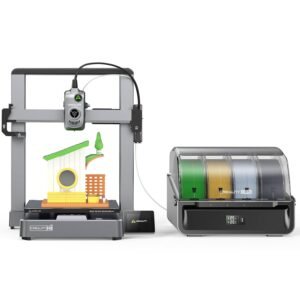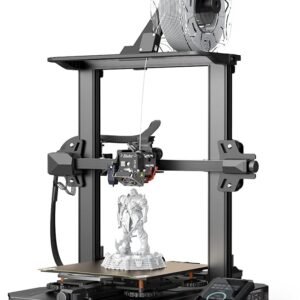Creality K1 3D Printer Review High Speed Precision and Smart Connectivity Features
Creality K1 3D Printer Review High Speed Precision and Smart Connectivity Features
- Prints exceptionally fast with speeds up to 600mm/s, making it 12 times quicker than many standard 3D printers.
- Features a new ceramic heater that reaches 200°C in just 40 seconds for rapid filament melting.
- Includes a dual-fan system for efficient cooling, ensuring models solidify quickly and maintain high quality.
- Equipped with hands-free auto leveling using strain sensors for precise calibration without user intervention.
As an Amazon Associate I earn from qualifying purchases.
Description
Highlights of the Creality K1 3D Printer Speedy Printing Machine
Testing the Creality K1 3D Printer Speedy Printing Machine,600mm/s High Speed,WiFi Control,Self-test,No Ring&Z-Banding,Auto Leveling,Extensible,Unibody Die-Cast,Out of Box,Smarter,12x faster,Beat Ender 3 revealed several standout qualities that grabbed my attention. The 12x faster speed compared to traditional FDM 3D printers is genuinely impressive. It achieves a max speed of 600mm/s and a whopping acceleration of 20000mm/s², which makes it feel like a rocket compared to the Ender 3 or CR-10 series I’ve previously tinkered with. The dual fans for quick cooling, combined with a ceramic heater hotend that heats up to 200°C in 40 seconds, contribute to an overall slick printing experience. I enjoyed watching models come to life quickly and with refined detail thanks to the smart G-sensor that reduces ringing and Z-banding—those annoying print artifacts that can ruin a project.
The unibody die-cast frame provides a rock-solid build platform, giving me confidence that the printer won’t wobble during those high-speed maneuvers. Plus, the enclosed chamber helps maintain temperature consistency, allowing me to experiment with a wider range of filaments without worrying about warping or cracking.
Advantages That Make It Stand Out
- Ultra-fast printing speeds with up to 600mm/s and 20000mm/s² acceleration, making it a game-changer for rapid prototyping.
- Self-leveling heatbed with strain sensors that work hands-free, which means no annoying manual calibration before every print.
- WiFi connectivity allowing remote control and monitoring through Creality Cloud or Creality Print apps, a real convenience when you’re juggling multiple projects.
- The smart OS running on a powerful dual-core 1.2GHz CPU enables smooth operation and future-proof extensibility like adding AI-powered LIDAR or cameras (though those are sold separately).
- Enclosed build chamber and dual fans ensure fast cooling and stable print quality, especially with more demanding filaments.
These perks made my printing sessions smoother and more enjoyable. The smart features combined with solid hardware give this printer a distinct edge in the desktop 3D printing market.
Limitations to Keep in Mind
- The high-speed printing requires special filament designed for rapid extrusion; standard PLA or PLA+ won’t cut it without slowing down the speed.
- Optional AI LIDAR and camera accessories are neat but must be purchased separately, adding to the total cost if you want those smart capabilities.
- The printer’s weight of 34.1 pounds and dimensions (roughly 14″ x 14″ x 19″) mean it’s not exactly ultra-portable, so you’ll want a dedicated workspace.
- While the WiFi control is useful, I occasionally experienced minor connectivity hiccups that required reconnecting the device.
- The price point, though reasonable for its tech, might be steep for hobbyists who don’t need the ultra-fast speeds or advanced features.
Having used it alongside my Ender 3 Pro, I noticed the need for filament adjustment was a bit of a hassle, especially when switching between regular and high-speed printing modes. It’s great if you’re into the speed, but casual printers might find this a bit overkill.
User Experience: What I and Others Noticed
My coworkers were intrigued by the creality K1’s out-of-the-box readiness. It arrived fully assembled and calibrated, complete with a quick boot-up guide and a self-test that gave immediate reassurance the printer was ready. In fact, my nephew, who’s just getting into 3D printing, found the hands-free auto-leveling to be a lifesaver because it removed the usual frustration of bed leveling.
Printing detailed miniatures and functional prototypes was a joy. The directional air ducts on the print head ensured that cooling was efficient, which helped solidify layers without deformities. However, the noise level during high-speed printing was noticeable, so it’s not the quietest printer in the room.
Product Rivals: How This Printer Stacks Up
Comparing this speedy machine to competitors like the Prusa i3 MK3S+ and the Anycubic Vyper, the K1 shines in speed and stability. While Prusa offers excellent print quality and reliability, its speed can’t match the 600mm/s capability. Anycubic Vyper is user-friendly with auto-leveling but lacks the advanced cooling system and powerful CPU the K1 boasts.
The unibody die-cast frame sets this model apart for durability—most rivals use aluminum extrusions that don’t feel as sturdy during operation. However, some competitors come at a lower price with fewer bells and whistles, which might be preferable for beginners who don’t need rapid prototyping speeds or WiFi control.
Price Performance: Is It Worth the Investment?
This printer’s tech-packed feature set justifies its price point, especially for those who value speed, accuracy, and smart connectivity. The ability to print 12 times faster than traditional hobbyist printers translates to serious time savings for professionals or enthusiasts with heavy workloads.
Still, casual users might find the need to buy special filament and optional accessories a bit of a dampener on the value proposition. If you’re after rapid prototyping with minimal fuss, this machine offers excellent bang for the buck. For those focused on occasional prints, a more basic model could suffice without the extra spending.
The Design and Build: Solid and Thoughtful
The black unibody die-cast frame is not only visually appealing but also engineered for maximum stability. It feels like a well-built tool rather than a flimsy gadget, which is reassuring during those high-speed print jobs. The enclosed chamber also helps control the environment, reducing drafts and temperature fluctuations.
I appreciated the self-test feature that runs when powering up, catching calibration issues before they become problematic. The WiFi connectivity paired with the Creality OS makes managing prints easier, with remote start, pause, and monitoring capabilities that keep me productive even away from my desk.
Print Quality and Feature Set Exploration
The upgraded max. 32mm³/s flow hotend with ceramic heating element instantly melts filament and ensures smooth extrusion. I experimented with various filaments including PLA, PETG, and specialty high-speed filaments. Print quality was consistently sharp, with minimal artifacts thanks to the smart G-sensor that effectively reduced ringing and Z-banding.
The dual fans work well to cool prints rapidly, but I recommend keeping an eye on fan noise during high-speed runs if you prefer a quieter environment. The auto-leveling system using strain sensors was a game changer—no more fiddling with knobs or paper tests before each print.
Summary of Key Positives
- Blistering high-speed printing up to 600mm/s
- Robust unibody die-cast frame for stability
- Hands-free auto-leveling system
- Smart WiFi connectivity and dual-core OS
- Efficient cooling with dual fan setup
Summary of Key Negatives
- Special filament required for maximum speed
- Optional AI features sold separately
- Relatively heavy and bulky design
- Occasional WiFi connectivity issues
Additional information
| Brand | Creality |
|---|---|
| Material | Creality K1 Speedy 3D Printer |
| Color | Black |
| Product Dimensions | 13.98"D x 13.98"W x 18.9"H |
| Compatible Devices | Personal Computer |













